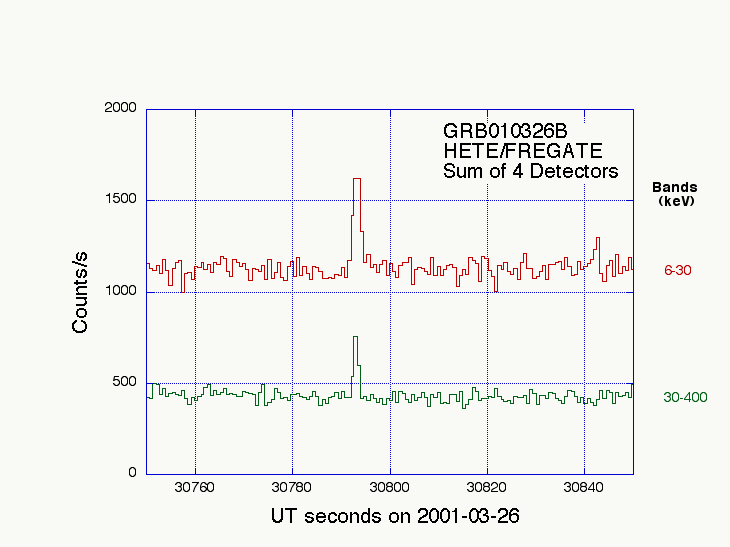
Gamma-ray Burst 010326B

(All information courtesy of the instrument teams.)
 Previous IAU Circulars
Previous IAU Circulars
 Results of Observations
Results of Observations
- GCN notice #1018
G. Ricker, D. Lamb, and S. Woosley on behalf of the HETE Science Team;
R. Vanderspek, G. Crew, J. Doty, G. Monnelly, J. Villasenor; N.
Butler, T. Cline, J.G. Jernigan, A. Levine, F. Martel, G. Pizzichini,
and G. Prigozhin, on behalf of the HETE Operations and HETE
Optical-SXC Teams;
N. Kawai, M. Matsuoka, Y. Shirasaki, T. Tamagawa, A. Yoshida, E.
Fenimore, M. Galassi, and C. Graziani, on behalf of the HETE WXM
Team;
J-L Atteia, M. Boer, J-F Olive, J-P Dezalay, and K. Hurley on behalf
of the HETE FREGATE Team;
write:
On 26 March 2001 at 08:33:12 UTC (=30792s UT), a soft spectrum, high
energy transient at high galactic latitude was detected and localized
by HETE.
(NB: This is the second GRB detected by HETE on 26 March 2001.)
Both the WXM and the FREGATE instruments detected the event. The
burst triggered FREGATE in the 6-120 keV band, at the 160ms timescale.
The preliminary coordinates of the burst are R.A. = 11h24m23.36s,
Dec. = -11o09'57", derived from combining data from the WXM and
Boresighted Optical Cameras. The statistical error radius in the WXM
localization is 18 arcmin (90% confidence). In addition, we estimate
a systematic error radius at present of 10 arcmin about this
location. The spacecraft aspect was known to an accuracy of +/- 30
arcsec (95% confidence) from the optical cameras, and will be
improved.
The peak flux seen with FREGATE (6-30 keV) was ~4 Crab; with WXM
(2-25 keV), ~2 Crab. The burst duration was about 4 seconds.
The high galactic latitude of the source, well away from the Galactic
Bulge, and the shape of its spectrum suggest that it is a gamma-ray
burst similar to those reported for "X-ray rich" GRBs by Heise et al
(2001) from BeppoSAX observations.
Follow-up observations of this unusual transient are encouraged.
Additional information on the GRB010326B (including light curves), as
well as for the HETE mission, is available at:
http://space.mit.edu/HETE/
Acronyms:
HETE=High Energy Transient Explorer
FREGATE=French Gamma Ray Telescope
WXM=Wide Field X-ray Monitor
SXC=Soft X-ray Camera
This message may be cited.

- GCN notice #1020
P.A. Price, T.S. Axelrod, B.P. Schmidt (RSAA, ANU), and D.E. Reichart
(Caltech) report on behalf of a larger international GRB collaboration:
"We have observed the error-circle of the HETE-2 GRB 010326B with the
robotic 50-inch telescope at Mount Stromlo Observatory starting at 2001
Mar 26.61 UT (6 hours after the GRB). Our 5x300 sec images cover the
entire error box, and go fainter than the DSS-2 red plates, although the
depth is severely affected in regions by the presence of a very bright
star. From a preliminary visual comparison of our images with the DSS-2
plates, we do not detect any obvious bright optical transient."
This message may be cited.
- GCN notice #1027
A. Henden (USRA/USNO) reports on behalf of the USNO GRB team:
We have acquired preliminary BVRcIc all-sky photometry for
an 11x11 arcmin field centered at the HETE localization
for GRB010326B (GCN 1018) with the USNOFS 1.0-m telescope
on one marginally photometric night with poor seeing. Stars
brighter than V=14 are saturated and should be used with care.
We have placed the photometric data on our anonymous ftp site:
ftp://ftp.nofs.navy.mil/pub/outgoing/aah/grb/grb010326b.dat
The current photometry has a potential external zero-point
error of about three percent. The astrometry in this file
is based on linear plate solutions with respect to USNO-A2.0.
The internal errors are less than 100mas. Note that there
are several bright stars near or in this field, causing
a few non-physical 'stars' to appear in the .dat file.
Be careful to check your images to ensure
that any selected stars are real.
Further calibration of this field will not be performed
unless an optical counterpart is discovered.
- astro-ph/0605570 from
22 May 2006
Donaghy: HETE-2 Localizations and Observations of Four Short Gamma-Ray
Bursts: GRBs 010326B, 040802, 051211 and 060121
Here we report the localizations and properties of four short-duration GRBs
localized by the High Energy Transient Explorer 2 satellite (HETE-2): GRBs
010326B, 040802, 051211 and 060121, all of which were detected by the French
Gamma Telescope (Fregate) and localized with the Wide-field X-ray Monitor (WXM)
and/or Soft X-ray Camera (SXC) instruments. We discuss eight possible criteria
for determining whether these GRBs are "short population bursts" (SPBs) or
"long population bursts" (LPBs). These criteria are (1) duration, (2) pulse
widths, (3) spectral hardness, (4) spectral lag, (5) energy Egamma radiated in
gamma rays (or equivalently, the kinetic energy E_KE of the GRB jet), (6)
existence of a long, soft bump following the burst, (7) location of the burst
in the host galaxy, and (8) type of host galaxy. In particular, we have
developed a likelihood method for determining the probability that a burst is
an SPB or a LPB on the basis of its T90 duration alone. A striking feature of
the resulting probability distribution is that the T90 duration at which a
burst has an equal probability of being a SPB or a LPB is T90 = 5 s, not T90 =
2 s, as is often used. All four short-duration bursts discussed in detail in
this paper have T90 durations in the Fregate 30-400 keV energy band of 1.90,
2.31, 4.25, and 1.97 sec, respectively, yielding probabilities P(S|T90) = 0.97,
0.91, 0.60, and 0.95 that these bursts are SPBs on the basis of their T90
durations alone. All four bursts also have spectral lags consistent with zero.
These results provide strong evidence that all four GRBs are SPBs.
Back to JG's
homepage
Jochen Greiner, last update: 29-May-2006
[Disclaimer]
![]() Previous IAU Circulars
Previous IAU Circulars 